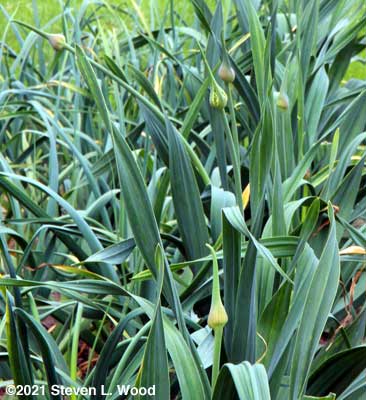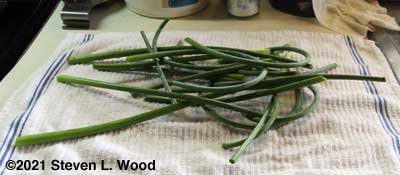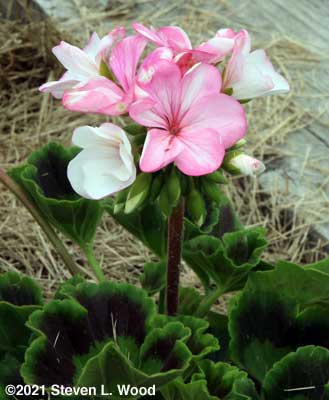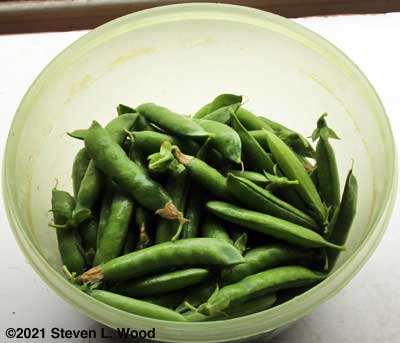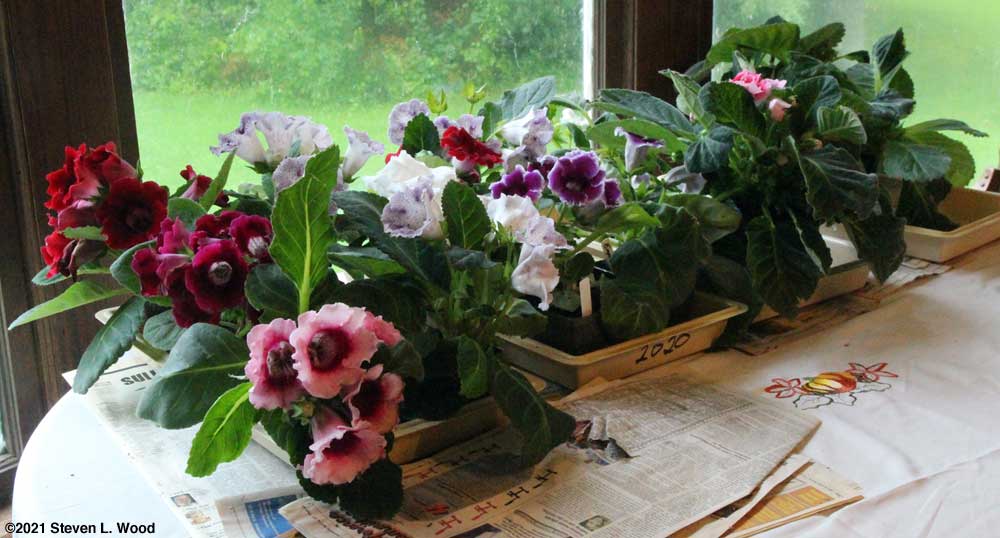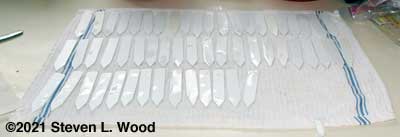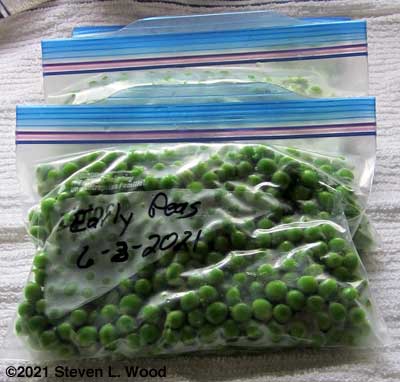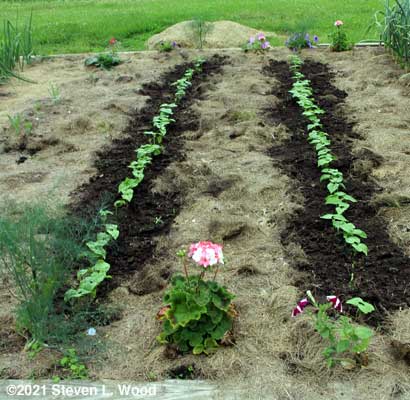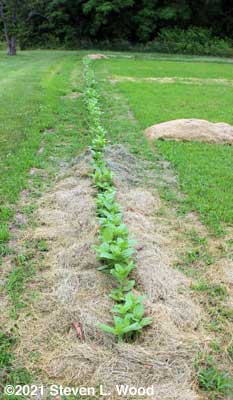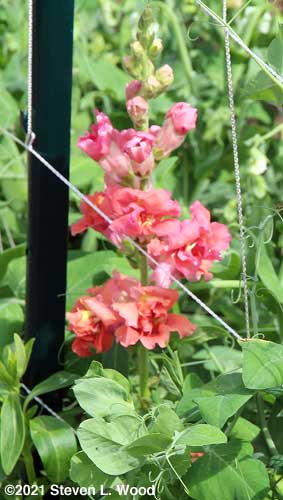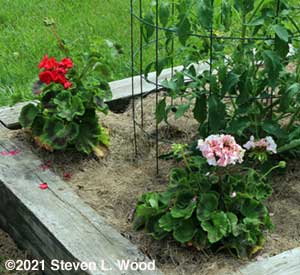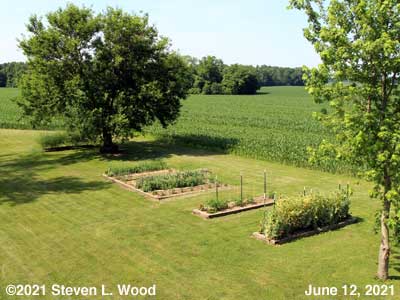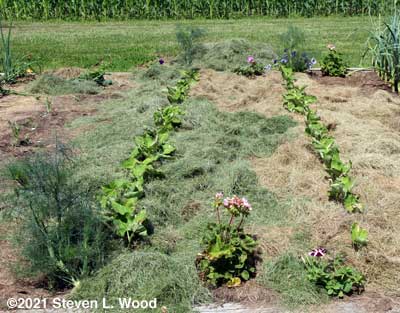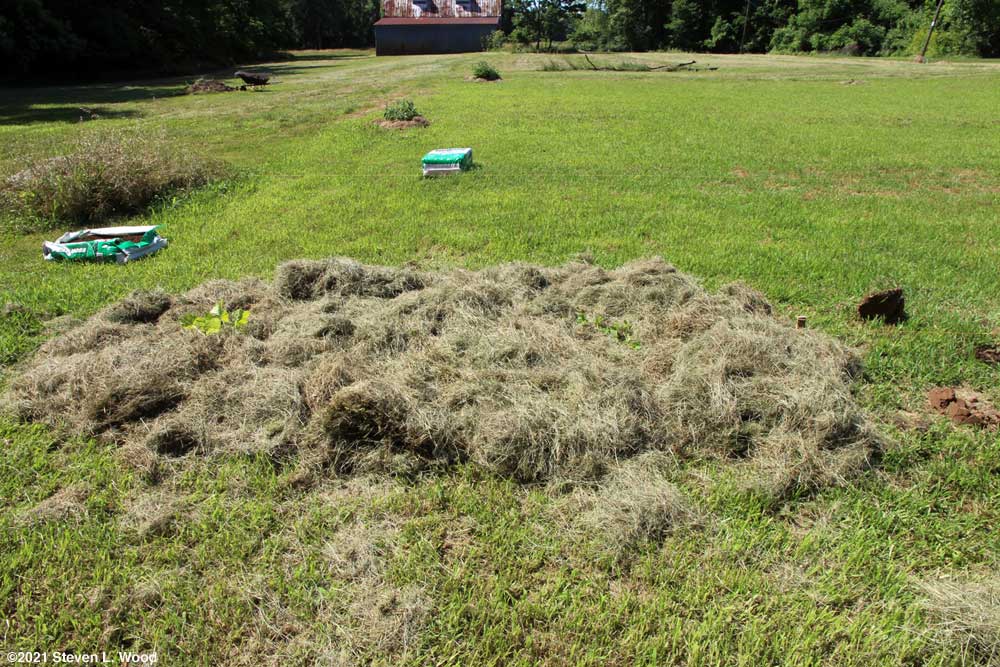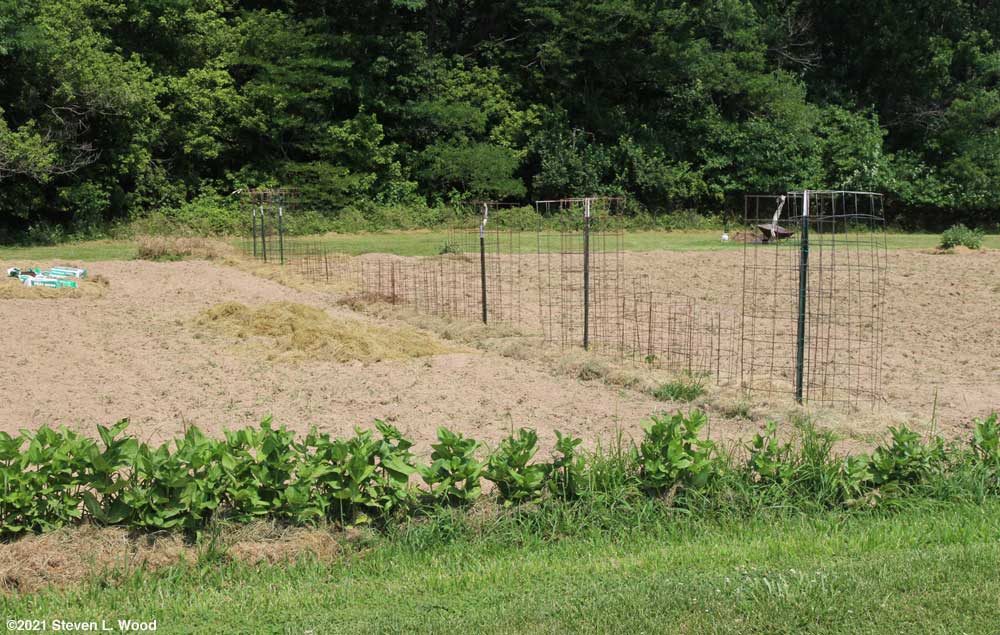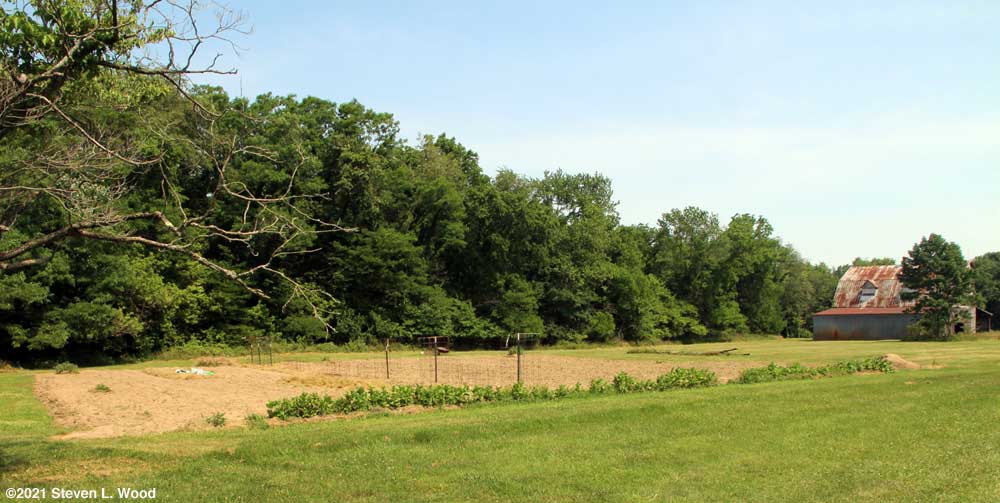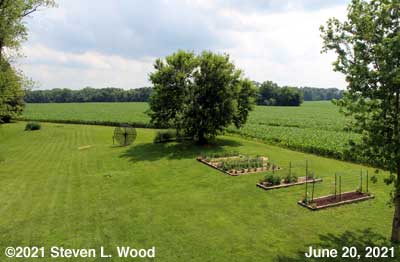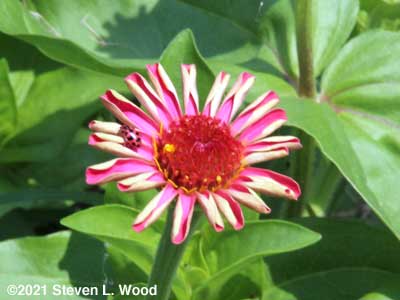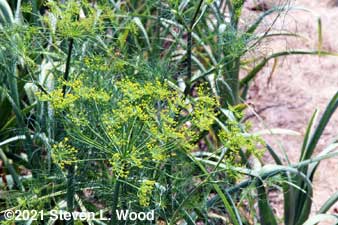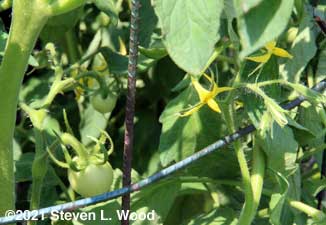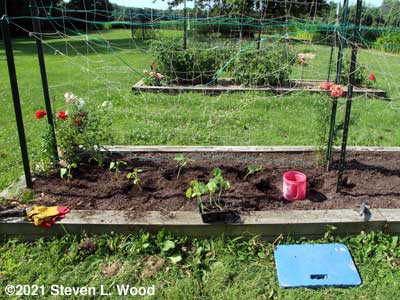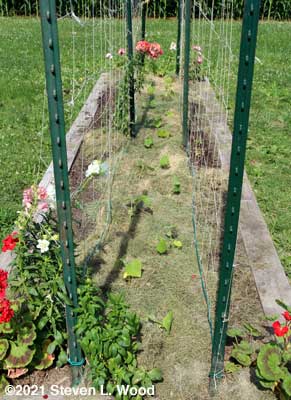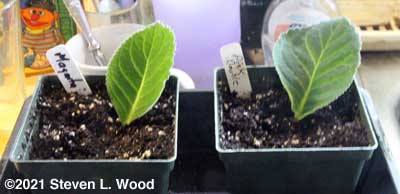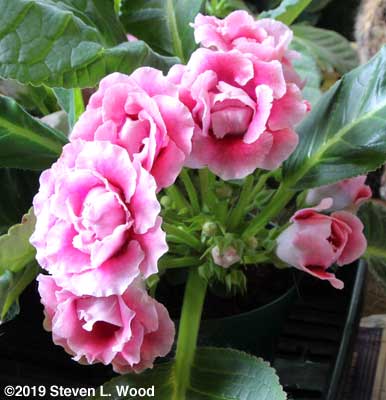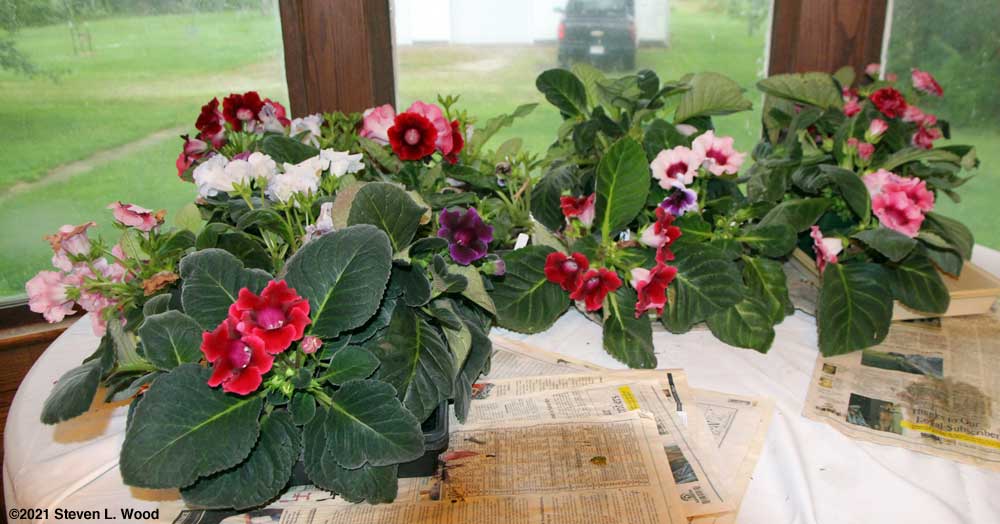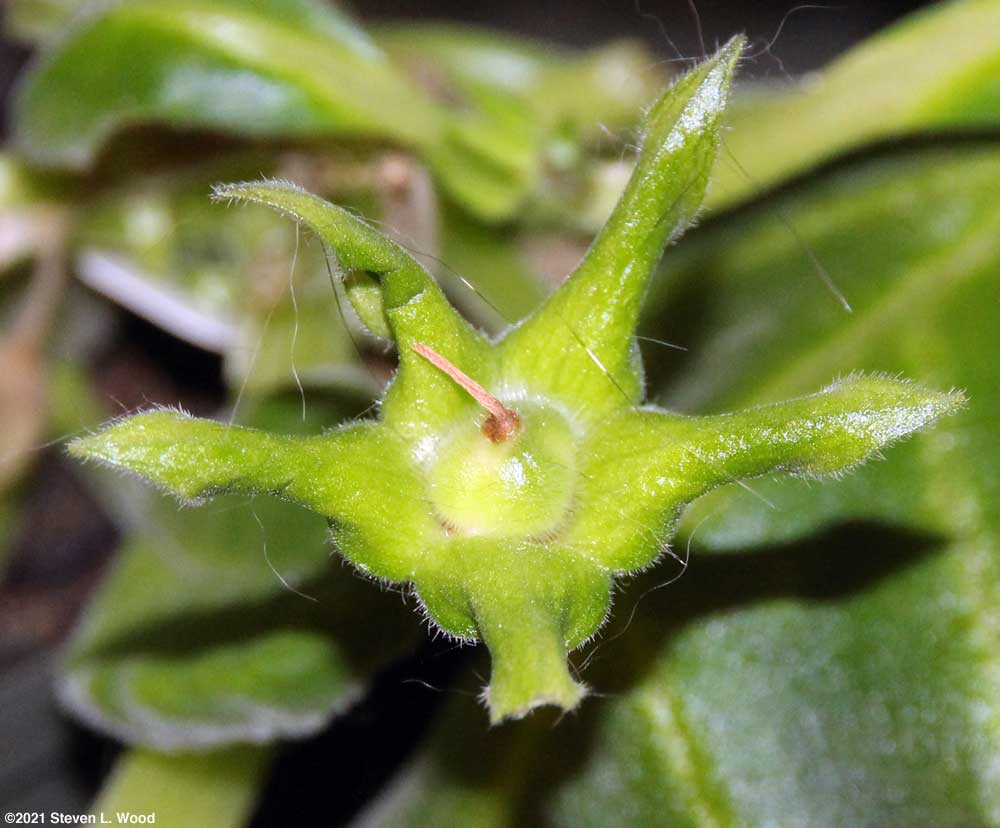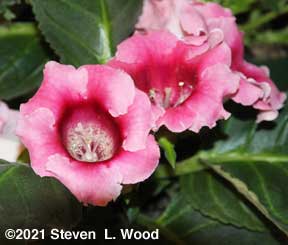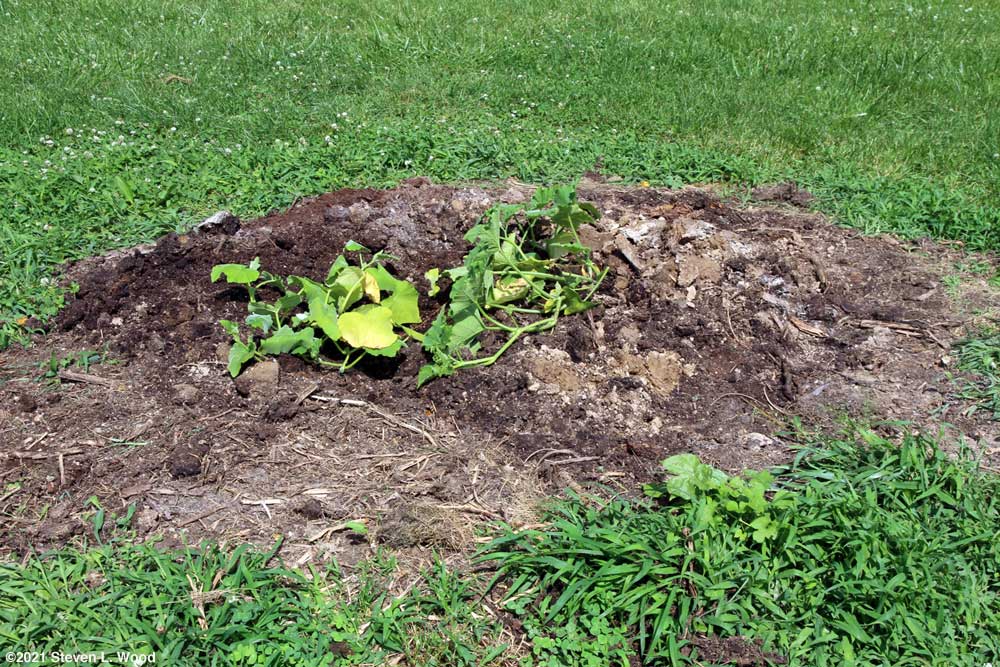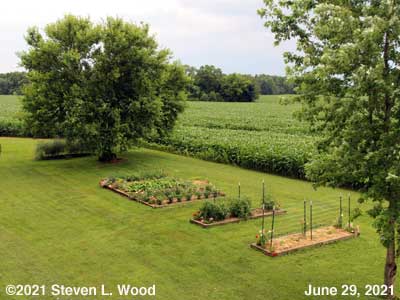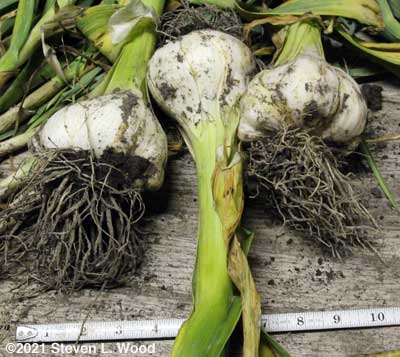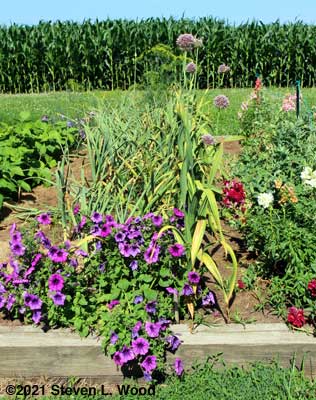One of the Joys of Maturity |
|
| Affiliated Advertisers |
Clicking through one of our banner ads or some of our text links and making a purchase will produce a small commission for us from the sale. The Old Guy's Garden Record Tuesday, June 1, 2021 - Garlic Scapes
I noticed yesterday that almost all of our elephant garlic plants and some of our hardneck garlic had put on rather rigid, central stalks known as a scapes. Scapes produce pretty blooms at their tops, although they don't pollinate, but vegetatively produce small bulbils that can be harvested and grown out to produce garlic bulbs...in two to three years. Scapes are also edible and store pretty well when bagged in the refrigerator. Bon apepétit's Christina Chaey relates 10 Things to Do With Garlic Scapes, the Best Veg You're Not Cooking Yet. I cut all but two of the scapes I could find, leaving the two to possibly produce their lovely "bloom" heads. The cut scapes got their bloom heads trimmed, stalks washed, and went into our fridge (in a green bag, of course). Later I chopped some and fried them with some round steak, giving it a bit of a flavor boost without an overwhelming flavor of garlic. We'll probably dig our garlic late this month or in early July. I noticed today that some of the garlic leaves are flashing (yellowing at the tips), a sign that they may need a boost of nitrogen for the home stretch. I share how we grow our garlic from planting to storage in Growing Garlic. Possibly far more helpful is the Boundary Garlic Farm by Henry Caron and Sonia Stairs. They've retired from the garlic business, but have kindly left their incredibly informative site online. Oh, and about those garlic blooms: They're gorgeous. Peas
Along with the round steak, mashed potatoes and gravy, peas were possibly the stars of our dinner tonight. As I ate, I realized that I'd finished off the peas before anything else.
The milkweed I transplanted into our back yard has been looking pretty puny. So I began soaking/stratifying more milkweed seed a week or so ago. I pulled the seed/vermiculite mix from the refrigerator this morning and spread it over some sterile potting mix in an eight inch bulb pan. The pan joined the cucumbers I started yesterday under our plant lights in a tray over a soil heating mat set to 75° F. I'd love to see some monarch butterflies on our planting of milkweed. |
|
In between showers, actually, in a light mist, I picked a couple of pounds of peas. That may sound and look like a lot until you begin shelling the peas. An interesting web site I found shared the following information on converting peas in the pod to edible peas in weight and volume:
Combined with the peas I didn't cook last night, today's picking should nicely fill a pint Ziploc Freezer Bag. Before the rain paused, I did a number of normal household chores. But I realized that I needed to label our newly blooming Empress gloxinia plants. Such jobs rarely get done on sunny days when I can be working outside. Each plant has a plastic plant label identifying the variety and date seeded. This morning, I added a second label to each plant in bloom that I hadn't previously labeled identifying its bloom color and noting double blooms when evident. Such labels are helpful when the plants are emerging from dormancy. All but two of the plants in bloom shown above are from a December seeding. A double pink just barely visible in the back of the shot and a white closer to the camera are older plants. The double pink's corm outgrew its six inch pot last year. When it broke dormancy several months ago, I moved it to the only appropriately sized pot I had for it, an eight inch hanging basket pot.
The labels get rinsed when they come out of the bleach water and dried on a kitchen towel. Once dried, they go into a larger old peanut butter jar and are stored in our plant room. Calling the white towels kitchen towels may be a compliment to them. They're actually bar mop towels I pick up in volume every few years at our local Sam's Club
Since I've used the same container to hold our peas each picking, I knew that I'd gotten far more pea pods today than in previous pickings. But I also saw that a few of the vines had begun to brown out, a sure sign of the end of these peas. I'm guessing we'll be able to pick for another week or so. I washed and shelled the peas and then combined them with some previously picked peas from the refrigerator. Following the directions in the Ball Blue Book Guide To Preserving I began our how-to on growing peas, Another Garden Delicacy: Homegrown Peas:
The peas frozen today were just a start on our annual pea harvest. Planting, picking, and shelling took a good many hours of effort. But the difference in home grown peas over store bought is well worth the effort...for us at least.
A little rain each day lately has made gardening and mowing more difficult. But it also has popped up the green beans I planted a little over a week ago. The rain has encouraged weed germination along the bean rows. A quick pass this morning with a scuffle hoe discouraged the weeds a bit. Keeping up with weeding our raised herb bed around our shallow well and our flowerbeds has also taken some time. And while I thought for a few days that I'd killed our oregano plants cutting them way back, they're beginning to regrow.
I used some Spreader Sticker instead of dish detergent for my mix. Both can work as a surfactant that "increases absorption, translocation and sticking of insecticides, herbicides, fungicides and liquid fertilizers." I've now made three passes with the homemade weedkiller, having greater success for some reason on the tomato/pepper row than the squash/melon row. But then, our tomato and paprika pepper plants are further along than our melon transplants.
My wife commented this morning that she could see blue sky when looking out of the front of our house. When I went out the back door to walk our raised beds, it was misting. So our wet spell continued this morning with our weather forecast calling for sunny skies the rest of the week. I may be back to watering again by this time next week. I noticed several things on my morning garden walk. Lots of our flowers lining our raised beds are now blooming. There are several snapdragons putting on quite a show. Our snapdragons get planted along our garden trellises, as the trellises provide some support for the tall plants. While the peas will eventually be cleared from the trellises, the snaps will remain amongst succession plantings of cucumbers and lima beans.
Our snapdragons this year are a mix of the Madame Butterfly
We also have dianthus, geraniums, and petunias in bloom. Our dianthus are all from saved seed, originally from the Carpet Snowfire variety. The petunias are the Celebrity variety which we've come to love for its diversity of bloom colors and styles. We had a vinca in bloom, but a heavy rain yesterday beat up its blooms.
Our early peas could have provided one more good picking today, but I'm going to let them go to produce seed for seed saving. Many of the vines are browning out, while others are still fully green with fat pea pods on them. Cutting of the picking season for our early peas was influenced by the volume of blooms and pea pods on our short, supersweet pea plants. Those pods should begin to fill out in the next few days.
I mowed both yesterday and today. I mowed and raked our yard yesterday and mowed the field today. I also set the blades on the mower way down and scalped our East Garden plot again. When I was mowing, temperatures were in the 90s with a heat index over a hundred. While riding a mower in that heat wasn't too bad, I did some mulching that quickly became pretty hot work.
I also picked our first supersweet peas this morning...a whole six pods of them. Since Annie and I each ate a pod of raw and very sweet peas, only four pods made it to the fridge. The peas picked today were all of the Encore variety. It's a 64 days-to-maturity variety while our other supersweet, Eclipse, are a 67 day variety. The Eclipse plants are filled with blooms now, but it appears that they will mature a bit more than three days after the Encores. We've had blooms showing on one of our Earlirouge tomato plants for several days. Our other five Earlirouge plants have as yet to put on a bloom. Interestingly, the blooming plant is from seed I saved in 1988! The other Earlirouge plants are from seed saved over the last seven or eight years.
Progress has been slow, but at least I'm getting some things transplanted. I put in four tomato plants, four paprika pepper plants, a hill of yellow squash, and a hill of cantaloupe. Part of the slowness of the process, beyond the heat spell we're experiencing, has been a change I've made in doing our deluxe planting holes. I usually mix lots of peat moss with the native soil in the East Garden. But since we have a productive finished compost pile, I'm planting into a mix of mostly compost and peat moss mixed with a little of the soil dug. The compost pile is shown in the upper left of the photo below along with my $1 farm auction wheelbarrow. The wheelbarrow gets filled with all the undigested material screened out of the compost and then gets dumped on our current compost pile. Our working compost pile got a shot of compost starter this evening. The recipe for the compost starter concentrate is a cup of household ammonia, a 12 ounce Coke (regular, not diet), and a quarter cup of dish detergent. The late garden author Jerry Baker recommended using a hose end applicator at a 15:1 water-concentrate ratio, but I just poured a bit of the concentrate in a 2 gallon plastic watering can that I reserve for this task. I've been on a bit of a sprint during some good, but very warm weather this last week. I felt sure that the soil in our East Garden would finally dry out enough to be tilled. It did, but just barely. I tilled today. Thunderstorms are rolling in this evening as I write.
Knowing we might not get to till and then plant, I went ahead and sort of no-tilled our tomatoes and paprika peppers and some squash and melons. I first tried treating the rows for the plantings with a vinegar and Espom salts homemade weedkiller that had worked for me in the past. Sadly, I put it on too sparingly and the grass weeds just came back. So...I went ahead and gave each transplant a deluxe hole filled with peat moss and compost, a little fertilizer, some lime, and lots of ground egg shell to prevent blossom end rot in the tomatoes and peppers. Each planting hole also got lots of a liquid starter solution made up of Quick Start, Maxicrop Soluble Seaweed Powder, and Serenade biofungicide. A heavy 6-8 inch layer of grass clippings surrounded each plant to hold back weeds and retain soil moisture. Typically every job took longer than I thought it would. A lot of that was of my own making, as I chose to use compost that had to be screened from our finished compost pile. Mulching with grass clippings for weed control involved mowing (twice) and using our lawn sweeper to collect the grass clippings. I ended up using every tomato and pepper cage I had. Two of the tomato cages were in pretty bad shape from encounters with the lawn mower. Two or three years ago, we had twenty-three tomato cages. This year I found only seventeen of them. Apparently, someone helped themselves to some of our rather expensive homemade tomato cages we store in the corner of a field over the winter. But in addition to our six Earlirouge tomato plants in a raised bed, we now have Moira, Quinte, and Crimson Sprinter open pollinated tomatoes from which we hope to save seed. We also have Bradley, Bella Rosa, Dixie Red, Mountain Fresh Plus, and Mountain Merit in the row. Normally, I would have run the tomato/pepper row right down the middle of our East Garden. But we brought in anthracnose on some contaminated tomato seed two years ago when we had our tomatoes in a row down the middle. So I moved the row ten feet away from where the infected row had grown. I chose not to grow any bell peppers in our East Garden this year, instead going with a variety of paprika pepper varieties: Hungarian Spice; Boldog Hungarian Spice; and Sweet Paprika Pepper. I also omitted any grape tomatoes this year, even though I had some healthy transplants available. Our squash and melon row is still a work in progress. I have put in hills of Slick Pik yellow squash, Sugar Cube and Athena cantaloupe, Ali Babawatermelon, and a combined hill of some rather sick looking Blacktail Mountain, Crimson Sweet Virginia Select, and Kingman watermelon transplants. I still have more watermelon, honeydew, and squash to put in.
It's been a tough gardening month so far. Lots of rain that would have better come last month has made working the soil difficult. Old age has also limited my gardening. I try to get stuff done in the cooler and less UV intensive hours of the morning. But mowing and raking hay has to be done when things dry out, so I spent a lot of hours on our lawn tractor this week mowing, raking, and tilling. On the upside, my lovely wife, Annie, picked peas for me this afternoon. Combined with what I'd picked over the last few days, the peas shelled out to make another pint of supersweet peas for the freezer. Our early pea vines have browned out, so it's almost time to pull those vines and save the seed pods for seed saving. Sunday, June 20, 2021 - Father's Day
I did note that several of our tomato transplants didn't make it and will have to be replaced. A deer also had a collision with a pepper cage. The cage was knocked over, but the paprika pepper plant looked okay. The tilled, unmulched portions of the East Garden still have lots of clumps of grass showing. The 50' x 80' area I won't be planting this year is seeded to buckwheat which should begin to emerge in just a few days. I worked last evening and today clearing and cleaning up our previous planting of tall, early peas. That involved removing the vines and collecting any mature pea pods remaining for seed saving. Once I'd moved the vines to our compost pile, I hoed in some lime and fertilizer and raked the bed smooth. Since some of the pea vines had developed downy mildew, I gave the soil a good sprinkling of Serenade biofungicide. While our Japanese Long Pickling transplants are ready to go into the ground, I'm going to let the sun work on the bare soil for a couple of days before transplanting. I took some twist ties with me to the narrow bed and used them to tie up some snapdragons that had fallen over. The snaps should bloom profusely for a while until the cucumber vines begin to overgrow them. One other job in the cleanup was to pull and bag Abundant Bloomsdale spinach plants along the sunny side of the bed that had seed on them. I hung a paper sack of seed bearing spinach plants in the garage to dry for a few days. It's a fun time to just look over our garden plots. I probably left too many garlic scapes to "bloom," but they are pretty. Likewise, the dill at the edges of our main raised bed has pretty yellow blooms and gives off a pleasant fragrance when one is working in the garden. And one of our tomato plants has set tomatoes.
The peas shelled out this morning are a mix of the Champion of England and Maxigolt tall pea varieties we typically direct seed in early March. They germinate well in cool soils and produce lots of sweet peas on five foot tall vines. This year's crop of saved pea seed is the first to grow from seed saved previously. For years I planted a row half and half to the two varieties from commercial seed, but decided to let them cross pollinate a little and save seed from last year's planting. So far, it appears that mixing the two varieties has turned out pretty well. With temperatures predicted to stay in the 70s, I may get out and do some transplanting this afternoon between showers.
On a more positive note, I had a lovely morning to work outside. A cold front had moved in, and I worked in sunny conditions at around 68° F! Having a near perfect day for transplanting, I took the last of our melon transplants to our East Garden and put them in. I continued my previous practice of filling the planting holes with a mix of compost and peat moss, using the dug native soil to form a ridge around the planting to hold water. I had just enough cured grass clippings to mulch around each planting, but not enough to mulch the whole row. The race to mow and mulch now begins to keep our East Garden fairly weed free. Last year we had 22 hills of melons in our East Garden. Having decided to go with just one short melon row instead of two long ones last year, I only had room for nine hills. I got more varieties in by transplanting multiple varieties in the hills. Two hills on either end of the row went to Slick Pik yellow squash. While Slick Piks are incredibly productive, they aren't long lasting. I'll be starting succession plants later this week to ensure some delicious yellow squash later in the season.
For cantaloupes, I went with longtime favorites Sugar Cube and Athena. Sugar Cubes are small, icebox size melons with incredible flavor. Athenas are large melons, also with great flavor. One of the Athena hills also had a Tam Dew honeydew plant in it. Our watermelons were a mix of open pollinated and hybrid seedless varieties. For pollinators and also great melons, I went with Ali Baba, our most dependable watermelon variety, and Crimson Sweet Virginia Select, which we trialed for the first time last season and found superior to the old standard Crimson Sweet variety. For our earliest watermelons, I planted Blacktail Mountains. They produce sweet, medium size melons early and even without full summer heat. Our seedless varieties this year are Farmers Wonderful, Red Ruby, and Kingman. We've successfully grown Farmers Wonderful melons for years. Red Ruby and Kingman are new varieties to us. For more complete information on growing melons on lousy soil, see Growing Great Melons on Heavy Clay Soil. We grow our melons on an old cornfield with heavy clay soil. We get some melons every year, and some great melons many years. I still hope to direct seed sweet corn and kidney beans into our East Garden. I've left space for them, and the soil in that area is drying out nicely. But it's getting pretty late for such crops. If I get the sweet corn in this week, it will be September before it matures. That's a far cry from my farming days when we began roadsiding 2-4 acres of sweet corn shortly after the Fourth of July. One job I wanted to do today didn't get done. I'd hoped to transplant our Japanese Long Pickling cucumbers into the narrow raised bed I'd cleaned up over the weekend. Old age and sore muscles suggested I wait a day or so for that effort. But the JLP variety is sixty days from seeding to maturity, so there's plenty of time left to get the cukes in. As I walked back to the house from our East Garden, I snapped a shot of our raised beds. Despite all the weather and critter challenges we've faced this season, we're doing pretty well. Of course, I started the day by dispatching three rabbits considering what damage they could do in our main garden with three shots of game shot early this morning. None died, but I think they got the idea. I didn't garden at all yesterday. Instead, Annie and I drove to Bloomington (IN) to see two of our daughters and four grandchildren we hadn't seen in over a year. It was a wonderful day. Busy Day
I moved on to transplanting seventeen Japanese Long Pickling cucumber plants into the narrow raised bed where our early peas and spinach had grown. I'd previously hoed in some lime and balanced fertilizer to the bed and soaked the soil with some Serenade biofungicide to suppress any powdery mildew that remained on pea plant trash I missed in the cleanup of the bed. So I only needed to give the bed a quick pass with my scuffle hoe before transplanting to disrupt any weed seed that might have been germinating. I was surprised to find the soil really dry. Each transplant got a six inch deep hole that I filled with dilute Quick Start fertilizer. I squished the rather dry rootballs of the transplants into the mud and drew a little soil around them before watering again. I finally pulled the last of the dug soil around the plants and firmed it with my hands. When I was done transplanting, I mulched almost the entire bed with a pile of grass clippings that had been sitting and curing for a week or so. I then lowered the side of the double trellis that had been raised to allow access to the area. While rain was predicted for later in the day (we got it), I pulled the hose out from our rain barrel and let thirty to forty gallons of water flow into the bed. This planting of Japanese Long Pickling cucumbers is the first true planned succession crop of the year for us. Of course, I've already replaced most of our brassica rows with green beans. But that was only because deer and rabbits destroyed the planting. I almost always follow our early peas with cucumbers, as they make good use of the double trellis that protected our peas from strong winds and the variety matured incredibly quickly (60 days from direct seeding to the first mature cucumbers). JLPs aren't my favorite cucumber for salads, but they are my favorite multi-use cucumber for slicing and making pickles.
Each cutting's stem got coated with some Clonex Rooting Gel along with some rooting hormone powder being stirred into the sterile potting mix they went into. And if you're wondering why a guy who already has way too many gloxinias might be cloning more of them, the image at right of the pink double plant may answer your questioning. Sweet Corn This month has been a race against time and the weather to get our East Garden plot planted. Ignoring a lawn that desperately needs to be mowed, I chose to till the planted half of our East Garden again this afternoon to facilitate planting sweet corn and kidney beans.
After measuring, staking, and stringing seven twenty foot rows for the planting, I used a garden hoe to open up shallow furrows for the seed. I planted American Dream (77), Vision MXR (75), and Anthem LR (74), in that order from north to south in the rows, filling the ends of the rows with saved red kidney bean seed. The sweet corn varieties are all somewhat short season varieties that should mature sometime in September. I also started two deep sixpack inserts of Summer Sweet 6800R (73) inside to fill in for any gaps in the plantings. (Values in parentheses are days-to-maturity figures.) One thing I left out in this planting was broadcasting balanced fertilizer over the sweet corn area before seeding. I thought about doing it before the final tilling, but decided to band fertilizer beside the rows once the seed germinates (I hope.). Also, I was in a race against a storm front coming in, trying to get the plantings done before it began to rain. In a break between rains this evening, I ventured out and grabbed a shot of the planted areas of our East Garden plot. Hopefully, the rain will pop up our sweet corn and kidney beans, as well as the buckwheat seeded over the rotated out portion of our East Garden. Something that got left out of our East Garden this season was potatoes. Being weathered out from tilling the area for a long time, it became way too late to try potatoes that don't do well in our annual July-August mini-drought. While I'll be hustling to mulch our melons and tomato plantings, I prefer to rototill for weed control in our sweet corn and kidney beans. Our twenty-seven year old walking tiller still does those jobs well.
I'm actually feeling pretty good about our garden, as I got our sweet corn and kidney beans planted yesterday. I still need to transplant our butternut squash plants, but I have to get our compost pile cleared first. That's where the butternuts will go. Butternut plants grown on the site of a previous compost pile generally don't need much fertilizer. Even with a rainy forecast. I hope to harvest beets and dig garlic in the coming days. I cut off picking our supersweet peas a few days ago to ensure a good seed crop.
After nesting elsewhere last year, barn swallows have a nest under our front porch. The posts supporting the porch roof have outcroppings that seem to be ideal for supporting a nest. Our gloxinias continue to put on quite a show. I did take the first plant to come into bloom to the basement this week. It currently looks pretty sad, but will add strength now for its next blooming cycle. Part of having so many gloxinias this year, other than just enjoying them, is having a wider selection of plants and bloom colors and types for hand pollination and seed saving. I actually sold out of gloxinia seed saved in 2020. It's not a big problem, as our seed packets are labeled as having seed from 2019 and 2020 in them. Gloxinia seed saves well in a freezer. After hand pollinating the blooms with a Q-tip over the last month or so, we have about a dozen seed heads maturing. The seed pods will eventually brown and split open. At that point, I prune them and squeeze the seed out of them for drying.
We're getting lots of colors and bloom types this year. While today really wasn't a gardening day, I did start some celery and our fall brassicas. I'm wondering about the celery, as it's a bit of a cool weather crop and I may have gotten it started a bit too soon for fall. So far, I've started Goliath and Castle Dome broccoli and Amazing cauliflower for our fall brassicas. Since critters destroyed our spring brassicas, I'm hoping for better things from this seeding. I ignored several other jobs that really needing doing today and focused on cleaning up our finished compost pile and getting our butternut squash planted. Our South Anna and Waltham Butternut squash transplants were huge. Any more delay in transplanting might have killed them. (It may yet!)
With it now being officially summer, I gave the butternut transplants a wider and deeper hole than usual, about two feet wide and a foot deep. I mixed peat moss, compost, 12-12-12 fertilizer, and lime in the holes, working it with a shovel into the native soil on the sides and bottom of each hole.
Since this planting is on the side of our East Garden that is shaded part of the morning, I'll need to keep a close eye on it to detect powdery mildew. I may apply a preventative spray or two of an organic fungicide. The location of the planting is well outside our East Garden proper, leaving plenty of room for the butternut vines to expand. Last year, I planted our butternuts and pumpkins in the East Garden. Each filled a 40' x 40' area with vines! With this late of a planting, our butternut varieties rated at 100 and 105 days-to-maturity (from a direct seeding) should just barely make a crop. It almost certainly won't be like last year's bumper harvest that allowed us to donate over 80 butternuts to our local food bank while saving a dozen or so for our use.
Once one quits picking asparagus, it's time to add some nitrogen rich fertilizer to the plants. I'd delayed this fertilization until I had some compost to double the effect of the fertilization. Before all that, I transplanted a bulb pan of asparagus into a relatively bare spot in the asparagus bed. I also transplanted more milkweed into the area where I'd transplanted some a month or so ago. I also weeded the milkweed area, a rather difficult task since I really don't know what baby milkweed plants look like. But I do know grasses and pulled them mercilessly from the area. Even with rain predicted, I'd hoped to switch out our lawn tractor from our pull-type tiller to its mower deck and mow. Sadly, that didn't happen. Just as I was finishing mounting the cleaned and serviced mower deck, we had a downpour. But the mower was ready to go when things dry out a bit. I really need to mow and collect grass clippings for mulch for our East Garden. Monday was a washout. Annie and I had business in Terre Haute. By the time we got home, I ate and fell asleep in my easy chair.
The garlic got as much soil as possible rubbed off its roots and moved to our drying table in the garage. I'll let the garlic cure there for a couple of weeks before trimming the leaves and roots from the garlic. Then the garlic will get bagged in old mesh potato bags and hung in our basement plant room. Now isn't the time to plant garlic in most of the northern hemisphere, but it may be time to begin thinking about it. If you need to order garlic bulbs, vendors often run out of their most popular varieties in July and August, even though planting time isn't until fall! I share our garlic experience from planting to storage in Growing Garlic. I finally got to mow our lawn this afternoon. The grass had gotten pretty high and left clumps of clippings I knew would be difficult to rake for mulch. But if I could get it all up, it would mulch a major portion of our East Garden. I came in to fix dinner at about 5:30 using a recipe for grilled chicken I'd found online. Using the recipe, I began marinating some chicken breast fillets at around 9:30 am. (Since my wife still works full time and I'm retired, I do most of the cooking at our house.) Part of the marinade recipe called for garlic and rosemary. I used fresh garlic I'd stolen from our planting a day or so ago and rosemary I'd saved years ago. We had a wonderful dinner. Just as I began to gear up and head out to rake grass clippings, a thunderstorm rolled in. It's been that kind of a month.
A Few Words About Our Charity Ads
Our site is required to carry a disclosure statement by the FTC that we will get a small commission on ads folks click through and make a purchase from. The charity ads you see on this site are another matter. We don't receive any payment from those charities. They are simply worthwhile causes we choose to feature here from time to time. The increased frequency of charity ads was driven by a bad experience I had last year. A charity I'd supported for years and who had sent me a calendar each year failed to do so last year. I wrote them a polite request for a calendar along with a contribution that was ignored! A little pissed, I wrote their CEO, but got no response...until March this year when I got three of their calendars in the mail with no note of explanation. At that point, I'd stopped running display ads for their charity on this site. But feeling like a bit of a curmudgeon, I decided to seek out other charities, many of which I have occasionally supported, and run their ads on this site. It's really disappointing when you give a charity $25 or $50 and then receive mail and email messages dunning you for more. Even more distressing are the "freebies" sent to shame you into giving more. I often wonder if a $25 contribution is wasted by the many "freebies" that come in the mail after the contribution. I'd encourage you to research charities seeking your support through the Charity Navigator site. It often reveals where contributions go, and more tellingly, how much their CEO skims off the top. High six figure salaries are not uncommon. Okay, that's off my chest. Have a good day/evening.
We didn't have all that many cull garlics which I usually use for making the powder. This time around I used two elephant garlic and around ten standard garlic bulbs. Today's job was to clean and peel the garlic cloves and run them through our food processor with its slice blade. The pasty slices then got spread across the trays of our food dehydrator. I once started dehydrating garlic in the house. That was a major mistake. Just from peeling the garlic, our kitchen reeks of garlic. I took the loaded food dehydrator to the garage and set its thermostat at 105° F. As the drying progresses, I'll cut it back to 95° F to prevent burning the garlic. It will probably take two or three days for the garlic to dry. When that occurs, I'll run the garlic through an old coffee grinder that we use only for jobs like grinding garlic or powdering herbs. I give a more complete description of making garlic powder in a September, 2015, posting.
Contact Steve Wood, the at Senior Gardening |
| Affiliated Advertisers |
©2021 Senior-Gardening.com


